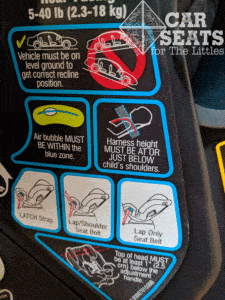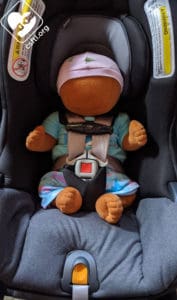A 2015 article by a major independent testing company made the recommendation to move from a rear facing only infant car seat to a rear facing convertible or multimode car seat sooner rather than later.
Since a majority of newborns come home in a rear facing only car seat and then switch to a convertible car seat when they outgrow their rear facing only car seats, this recommendation could impact that practice a bit.
Making the Transition
While there are many convertible car seats that fit newborns well at birth, the convenience of the rear facing only car seat often wins out and many families use that type of car seat to bring baby home from the hospital
Height and Weight Limits
All car seats have weight AND height limits that help determine when the seat is outgrown. There are three different ways a child can outgrow their rear facing only car seat.
- Weight. Once the child has reached the maximum weight limit of a rear facing only car seat — in most cases those weight limits range from 22-40 pounds — the seat is outgrown.
The next step is a rear facing convertible or multimode car seat. - Space above the child’s head. Rear facing only car seats require at least 1 inch of space in the seat’s shell above the child’s head at all times. Once there is less than one inch of shell above the child’s head, the car seat is outgrown.
The next step is a rear facing convertible or multimode car seat. - Stated height limit. All rear facing only car seats have a stated height limit. Once the child is taller than that stated height limit, regardless of how much they weigh or how much space is above the child’s head, the seat is outgrown.
The next step is a rear facing convertible or multimode car seat.
In most cases, rear facing only car seats (and most other types of car seats and booster seats) are outgrown by height before weight.
Many children can ride safely in their rear facing only car seats for most of their first year of life, sometimes longer. We suggest taking some time to research your child’s next step — a rear facing convertible or multimode car seat — before your Little needs to make the move.
When to Make the Switch
There are many reasons to switch a child to a rear facing convertible or multimode car seat earlier than later. For some convertible car seats, once a child is sitting unassisted and/or weighs 22 pounds, the seat can be installed much more upright which means the car seat takes up less room front to back than even a compact rear facing only seat.
Some infants seem to be more comfortable in a rear facing convertible or multimode car seat that sits them up higher on the vehicle seat than their rear facing only car seats did. Many children find that increased visibilty out the window more comfortable. Sometimes, the change to a convertible or multimode car seat may equal less crying and a more peaceful ride for everyone in the vehicle.
Other situations
- Children may have a medical reason including reflux, where laying in a more reclined position in a rear facing only car seat may be quite uncomfortable.
- The shape of their seat may make them uncomfortable.
- Some children find excessive stitching or quilted padding on seat covers uncomfortable.
Moving to a more upright and potentially more flat backed convertible or multimode car seat instead of a more curved rear facing only car seat will ease the pressure on their stomach, giving them a little bit of relief.
Many parents grow tired of carrying the infant carrier plus a heavier infant tiring. This scenario is an equally valid reason to move to a rear facing convertible or multimode car seat.
For other parents, having to fight a child who is on the brink of outgrowing what has become a very small seat is also very tiresome. Your baby fit with so much room to grow at the start, but now several months later it’s back to all arms and legs as they’re seemingly oozing out of every side and they have opinions that make them not want to get buckled. Then it may be easier to buckle them into a seat already in the car where their fit is a little more manageable.
No matter when you move your child from their rear facing only car seat to a rear facing convertible or multimode car seat, best practice is for children to ride rear facing until they’ve outgrown their convertible or multimode car seat by height or weight. In most cases, best practice means riding rear facing until the child is roughly 3-4 years old.
Seat Selection
The best seat is one that fits your child, fits your budget, fits your vehicle, and can be used properly every time. Here are some important points to consider when selecting a convertible or multimode car seat:
- The seat fits your child. There are convertible car seats with rear facing weight limits up 50 pounds and height limits up to 49 inches tall. Petite children have more choices when it comes to a long-lasting car seat than their taller or heavier counterparts. Knowing where your child falls on the CDC growth chart can help when choosing a car seat.
- The seat fits your budget. The CSFTL recommended car seat list has convertible and multimode car seats in a wide range of prices. Knowing your budget before shopping can help narrow down the seats at which you can look. If your budget is low, looking at a high end car seat won’t make things easier.
- The seat fits your vehicle. There’s a huge difference between a Chevy Cruze and a Ford Expedition. Know your vehicle and give yourself time to research car seat sizes before buying. If you have a store that allows you to try car seats before buying, take advantage of it. This may mean different car seats for every vehicle in which the child rides.
- The seat can be used properly every time. Some car seats can be harder to install and use than others, and if you know there are limitations with caregivers such as arthritis, weakness, etc, it’s important to have a seat that everyone can use properly. This may mean different car seats for different caregivers. Also, tools like the Buckle Bopper and Unbuckle Me may help make things easier for some caregivers.
In the end, when to switch to a rear facing convertible or multimode car seat is a personal choice as long as the child has not outgrown their rear facing only car seat. Allowing enough time to research can take the stress out of selecting the right seat.
Logistics
Once your baby has stopped using the rear facing only car seat, there is a small gap left in your routine.
First, what do you do with the seat you’re no longer using? Storing an unused seat can help with planning for a future Little. While the seat is stored the lifespan is still ticking down to its expiration, and it may be recalled while it’s not in use. Double check the car seat for expiration and recalls when you pull it back out of storage.
Heading into the House
Now, instead of loading up your child in the house and covering them with a blanket while you carry them out, you’ve got a child either in your arms or walking under their own power to the car. This is a new way to get into the car, and the transition will add a little extra time to your routine. Especially in the colder months, instead of putting a blanket over a child in a rear facing only seat, now you may need a few extra minutes to remove a jacket, maybe their boots, and get them buckled up in a colder car. Remember, wearing a bulky coat or snow suit is not safe in the vehicle for any passenger.
Getting into the Car
Often about the time most parents transition to a rear facing convertible or multimode car seat is also at the height of separation anxiety, the little newborn is long gone and a larger opinionated nearly child is in their place. Allow some time to determine the best way to get your child into their new car seat.
Maybe it works best to sit next to the seat and scoop them up and put them in bum first. Or maybe they’re walking and very much in the “I do it myself” stage and the easiest way is to allow them to climb in on their own. Keep in mind how big your child has gotten and how big they may get before they can get themselves into their seat. You may not want a tall seat with high sides if you have a 30 pound one year old and a tall SUV. Or if you have a small two door car, since then your available space to get a child in is nearly gone. Remember these as you start doing your research before you transition to a convertible.
Best Practice
Whenever your family makes the transition from a rear facing only infant car seat to a rear facing convertible or multimode car seat, best practice is when that child rides rear facing until they’ve reached the height or weight limit of that car seat.
Additional Resources
Our Facebook page or group can offer advice and suggestions for families who are making this transition.
Originally written by Jennifer Penick. Edits lovingly maintained in her memory by the CSFTL Editorial Team.





